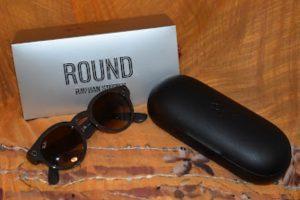In 2004, I traveled through Japan for a bit via bullet train, motorcycle and car, and while I was very focused on motorcycles at the time, I also immediately noticed that many people were riding some very unusual and innovativebicycles,the likes of which I had never seen before. Closer inspection revealed them to be electrically-assisted bikes, and some had Yamaha badges on them. They were typically commuter bikes, often ridden with kids and cargo aboard, since that’s how many people get around in Japanese urban areas. Cars are a luxury in ultra-dense Tokyo, and if you go to a grocery store there, the tiny parking lots are jammed with bicycles—not cars. And if it rains? Then you ride with an umbrella, like so:

A little rain doesn’t mean you stop riding and run to your car in Tokyo. Photo: Daniel Schallau
Yep, that’s me, giving it a go like a local. It was great fun. But more importantly, those then-fancy and expensive “electric bicycles” were a peek at the future of bicycling—and the oncoming wave of electric mobility—about a decade early. I bought my first ebike in 2016, but by that time, Yamaha had been making them forover 20 years.Just recently, I got the chance to try out two of their latest offerings, theWabash RT and the CrossCore RC, two new mid-motor machines coming to the U.S. and other markets and featuring the latest Yamaha electric mobility tech.
Like many companies that make wheeled machines, Yamaha is about to go heavy on electrification, and several recent announcements may be giving a peek at what’s to come in the next few years. Yamaha has recently introduced a spate of electric machines, includingcity scootersand now asecond-generation electric trials bike, which makes an electric road bike seem oh so tantalizingly close. Is there an electric Tenere or R1 waiting in the wings? I talked via online video call withNaoto Horie日本雅马哈的公共关系组what might be coming to showrooms soon, but more so about Yamaha’s “big picture” approach to electrification. Horie would not confirm any of my speculation around electric street bikes, of course, instead saying that Yamaha is very focused on bringing electrified products to market in line with the wants and needs of their customers—and as the technology hits performance benchmarks.
That may seem like corporate-speak or just corporate common sense, but in the electric mobility space, making electric motorcycles remains a fairly complicated endeavor, especially at this nascent stage of vehicle electrification. It’s telling that so far, no legacy Japanese motorcycle maker has offered a full-size electric street bike, while Harley-Davidson has and some others,like Can Am, are getting into the segment. Sure, a company with the R&D capabilities and fiscal might of Yamaha could drop an electric R-series sportbike on the world if they wanted to, but Horie was clear that, while that may happen at some future point, at this time they are far more focused on market segments like electric bicycles and electric scooters, as that’s where customer demand is greatest, especially in Asian markets.
Outside the U.S., Canada and the UK, scooters and ebikes sell in themillionsand make up a critical portion of the transportation matrix. The U.S. and other markets, by comparison, are not only smaller, but the use of scooters and ebikes is primarilyrecreational, while many customers in Asian and other major markets utilize the machines forcritical business and daily personal transportation needs. For now, Horie told ADVrider.com, that’s where Yamaha’s emphasis will stay focused while they work on solving the technical issues, especially range, that currently limits the appeal of electric motorcycles for recreational riders. But clearly, electric scoots like thenew NEO modelslook like they can have some fun getting riders from A to B and back.
However, Horie also said that Yamaha is of course focused on future electric markets, including recreational riders, and that’s evident from their recent introduction ofthe Yamaha TY-E 2.0 electric trials bike– the second generation of the model, no less. While the TY-E 2.0 isn’t street legal, it speaks to Yamaha’s finger on the electric pulse of one possible future of motorcycling. And despite the seeming rush to electrification for bicycles, scooters, cars and motorcycles, including many self-declared 2035-ish “deadlines” for the the end of making ICE vehicles from many manufacturers (mostly automobiles), Horie said that Yamaha understands many riders are very loyal to the company’s gas-powered machines and that they won’t be going away anytime soon.
事实上,冰自行车将继续开发了一个d made as long as there is sufficient demand from customers, and for now, Horie said the majority of their customer base is still dedicated to gas-powered machines, so don’t expect Yamaha to turn into a 100-percent EV maker anytime soon. For now, Horie said Yamaha will continue to create cutting-edge gas-powered fun machines while developing the tech needed to bring new electrified products to market. As you might well imagine, it is a complicated period for Yamaha and other companies, but also one of tremendous opportunity if the new e-machines meet or exceed customer expectations.

The Yamaha CrossCore RC is fast, fun to ride and can play in the dirt as well. Photo: Yamaha Motor Corporation
But back to the new ebikes. The $4,099USD Wabash RT and the $3,099USD CrossCore RC feature the same core technologies but are focused on different kinds of riders. The CrossCore RC, the name of which may conjure up images of muddied riders clambering up sloppy slopes, is actually the more commuter-focused of the two, with flat bars, suspension fork, headlight and an upright riding position.
The Wabash RT is the more focused “gravel bike” a cyclocross rider might choose, with angled drop bars and a more sporting stance, no suspension and a quick-shifting Shimano 11-speed derailleur properly activated by the front right brake lever. The CrossCore includes a Shimano 9-speed rear cassette and typical push-button shifters on the right grip. There is no front derailleur on either bike due to the electric motor. And despite being a more sport-oriented bike, Yamaha says the Wabash can be kitted out with optional OEM racks and such for commuting.
Both bikes feature Yamaha’s newest generation mid-mount PW-Series ST 500-watt electric motor, designed in-house for seamless integration into the frame. The 500-watt-hour, 36-volt lithium-ion batteries sit inside the lower frame rails but are removable as well. A sophisticated four-sensor IMU measures pedal rpm, pedal input effort, and also the incline and angle of the bike. A speed sensor in the rear hub also sends data to the LCD screen on the handlebars. Both areClass III bikeswith assist up to 28mph but no thumb throttles for freewheeling. Yamaha told me that they made that choice for maximum compliance with the various ebike regulations in the U.S., E.U., and other markets.

Photo: Bill Roberson
I rode the 52-pound CrossCore RC (above) on city streets and then headed off onto some urban dirt trails that ran along power lines and drainage areas, and found it to be equally at home in both environments. The 27.5-inch wheels and lightly knobbed CST tires had good traction on both dirt and pavement, and if you’re an ADV rider looking for a first electric bike, I’d probably go with the CrossCore RC, as I felt most at home on it due to the more upright bars, front suspension fork and predictable behavior in the dirt.

Big hill, big rider, and thankfully, big power from the refined Yamaha 500-watt pedal assist system. Photo: Yamaha Motor Corporation
The Wabash RT (above) was definitely the more “bike-focused” of the two, with the drop bars, 11-speed rear end and a bit less weight at around 47 pounds. We stuck to the streets for the most part on the Wabash, but put the pedal assist tech and power to the test with a long,longand steep climb up several miles of California hills outside San Marcos. Some truly fit riding enthusiasts were in our group and while my athleticism is certainly suspect after a severe shoulder injury and using COVID as an excuse to avoid the gym, the Yamaha’s auto-tuned pedal assist shielded my fragile pride and kept me in the mix up the hills, thankfully.
Yamaha doesn’t demand riders connect their ebikes to an app, you just get on, power up and ride. That said, the tech on the bikes is very sophisticated, and both models include a sort of hidden “automatic” power assist function that changes motor output across a wide range depending on riding conditions, effort, incline and other factors. You can still manually adjust assist across five levels but on the street, the Auto setting was the clear winner, dialing up big assist power on the hills and slacking it off on the flat sections. Think of it as a sort of automatic transmission that works in concert with your manual gear choices on the rear derailleur. It worked brilliantly—on the street. Out in the dirt, I found Auto to be almost too aggressive at some points, but the effect was minor and it wasn’t like it sent me speeding off into the weeds. But I popped the assist into manual mode a few times on some technical climbing sections, and having both options is a definite plus.

Yamaha’s newly designed electric motor is small, quiet and powerful, and looks a bit like a motorcycle clutch assembly. Photo: Bill Roberson
A very bright point on both bikes are the excellent Shimano hydraulic brakes front and rear. Power is linear and when taken to task, stopping power was impressive, especially when I came bombing down a very steep hill at 40-plus mph and had to light them up to avoid running a red light. I could smell them but fade was minimal and repeated heavy-handed abuse didn’t seem to faze them. Likewise, the rear Shimano shifters on each bike were quick and accurate. Yamaha told us that the bikes we were on were “prototypes” but these were clearly very close to production spec.
I’ve been riding and reviewing ebikes for years and the new Yamaha Wabash RT and CrossCore RC are excellent choices for a wide range of riders, even if you’re a long-time cyclist or haven’t been on a bicycle since your old Schwinn 10-speed. And the beauty of the electric pedal assist is that no matter your level of fitness, the battery power will expand how far you can ride and where you can go, while the excellent fitment and design of both bikes made them comfortable and fun on our outings. From a company that makes some of the top-performing motorcycles in the business, I expected no less, and came away impressed with Yamaha’s innovation, integration and performance capabilities on both bikes. As of today,you can order your own from Yamaha or a local dealer.
Are you a bicycle rider, ebike owner or interested in an ebike? What ‘s your take on the electric motorcycle tech that’s currently available? Tell us about it in comments.







